Analysis of NBA Player Performance, Popularity and Salary
Info: 7219 words (29 pages) Dissertation
Published: 5th Jan 2022
Tagged: SportsSocial Media
ABSTRACT
National Basketball Association is a major basketball league for men in America; united of 30 teams . It is recognised by FIBA which is also known as the national governing body for basketball in USA. NBA players are the world’s best paid athletes. NBA advance statistics are kept to estimate an individual or a team’s performance to analyse their social activities and interaction with their social network. This paper aims at finding relations to player’s salary with their performance along with their twitter follower by analysing the linear regression, PCA, SVM and Decision Tree technique.
Key Words:
Linear regression Model, PCA, SVM, Decision Tree and NBA.
Research Question
“Does engagement on social media correlate with popularity on Wikipedia?
Is follower count or social-media engagement a better predictor of popularity on Twitter?”
Research Hypotheses
“NBA players with certain set of proficiencies/characteristics are more likely to have more twitter followers than other players”.
Introduction
Though the analyses of game-related statistics have been popular among coaches for a long time, the types of data collected and algorithm created have been constantly evolving to better serve changing analytical needs. This paper is intended to take advantage of advanced statistics, such as game played in a regular season, efficiencies against opponents, points scored, PACE, rebounds, blocks, steals, twitter followers etc., that any team collects proprietarily in order to analyse the usefulness of these variables in characterizing and understanding the player’s contribution to their teams success.
Data Description
Gathering the NBA data represents a nontrivial software engineering problem. Knowing that the ultimate goal is to compare the social-media influence and power of NBA players, In theory, this would be an easy task, but there are a few traps to collecting NBA data. The intuitive place to start would be to go to the official web site at nba.com., that is, downloading from a web site and cleaning it up manually in R Studio. The data set comes from a NBA advance statistics data from Kaggle
Which has 63 variables and 101 observations.
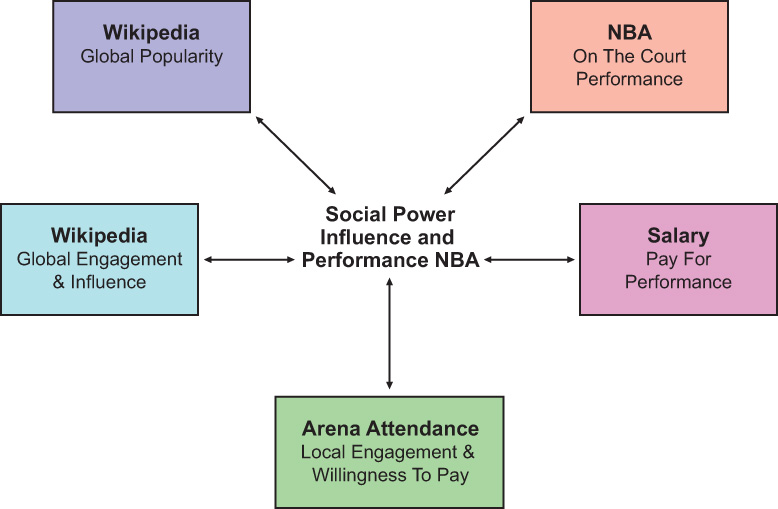
Processing the data
In order to prepare the data, data is splitting in training and testing data by using simple R code.70 percent of data was used for training and remaining data set was kept for testing the model. Finally cross validation was done to test data and check the model performance.
Principal Component Analysis
PCA is a dimension-reduction tool that can be used to reduce a large set of variables to a small set that still contains most of the information in the large PC1 have 67% of the variance, PC2 have 18% , PC3 have 7.5% and PC4 have 2.5% and the others are not that significant. The cumulative proportion shows that more than 97% variance is covered up to PC6.

Regression Model
Multiple linear regression , a supervised learning is used to compare the relation between the respond variables and the other dependant variables. In order to compare residuals for different observations one should take into account the fact that their variances may differ. A simple way to allow for this fact is to divide the raw residual by an estimate of its standard deviation by calculating the standardized residual.

Standardized residuals are useful in detecting anomalous observations or outliers. From the above influential plot it is clear that this NBA data observation is influential • Size is not proportional to Cook’s distance. Its more on the right, so there is a low leverage in the model.
now build a new regression model using the ‘SALARY_MILLIONS variable and test for heteroskedasticity by using the ‘gvlma’ package,
For Level of Significance = 0.05
Summary of the best fit:
Call:
lm(formula = SALARY_MILLIONS ~ AGE + TS_PCT + USG_PCT + PTS +
TWITTER_FOLLOWER_COUNT_MILLIONS, data = nba)
Coefficients:
(Intercept) AGE
4.4839 0.5723
TS_PCT USG_PCT
-24.1342 -41.3052
PTS TWITTER_FOLLOWER_COUNT_MILLIONS
0.9497 0.3960
This tests for the linear model assumptions and helpfully provides information on other assumptions. In this case focus is at the heteroskedasticity decisions, which has been identified as not being satisfied. Therefore need to reject the null hypothesis and state that there is heteroskedasticity in this model at the 5% significance level.
Finally , the below table shows that the assumptions are acceptable, and therefore it clearly state that heteroskedasticity is not present in this model. Lastly, it will demonstrate that the model has corrected graphically. As per previously, the first and third plots are the ones to look at. In the corrected plot the red lines are much more flat, and that the residuals are no longer clumped in locations. Therefore it shows that it has corrected heteroskedasticity in the model.
gvlma (x = fit)
| Value | p-value | Decision | |
| Global Stat | 4.8228 | 0.3060 | Assumptions acceptable |
| Skewness | 0.1556 | 0.6932 | Assumptions acceptable |
| Kurtosis | 1.3310 | 0.2486 | Assumptions acceptable |
| Link Function | 1.3977 | 0.2371 | Assumptions acceptable |
| Heteroscedasticity | 1.9384 | 0.1638 | Assumptions acceptable |
Decision and results
Call:
lm(formula = SALARY_MILLIONS ~ AGE + TS_PCT + USG_PCT + PTS +
TWITTER_FOLLOWER_COUNT_MILLIONS, data = nba)
Residuals:
Min 1Q Median 3Q Max
-12.622 -4.374 0.079 4.361 12.819
Coefficients:
Estimate Std. Error t value Pr(>|t|)
(Intercept) 4.4839 11.1064 0.404 0.687332
AGE 0.5723 0.1590 3.600 0.000511 ***
TS_PCT -24.1342 13.1209 -1.839 0.069018
USG_PCT -41.3052 19.7657 -2.090 0.039341 *
PTS 0.9497 0.1501 6.326 8.44e-09 ***
TWITTER_FOLLOWER_COUNT_MILLIONS 0.3960 0.1522 2.602 0.010757 *
Signif. codes: 0 ‘***’ 0.001 ‘**’ 0.01 ‘*’ 0.05 ‘.’ 0.1 ‘ ’ 1
Residual standard error: 5.88 on 94 degrees of freedom
Multiple R-squared: 0.5751, Adjusted R-squared: 0.5525
F-statistic: 25.44 on 5 and 94 DF, p-value: 3.815e-16
This output indicates that the fitted value is given by-
Y= 4.4839 + 0.5723X1 -24.1342X2 -41.3052X3 + 0.9497X4 + 0.3960X5
Inference in the multiple regression setting is typically performed in a number of steps. the summary statistics that the linear model yields a strong R2 result with an adjusted R2 of 0.6978
The significant F-statistics from the Wald test further confirms that the linear model decently fits the data and could potentially be used to make future forecasts .
As demonstrated in the residual vs. fitted value plot and normal Q-Q plot below, the linear model results in a very good fit except on a few data points. Data points like this will make the tail in Q-Q plot deviate from their expected position, and they should be analysed case by case. However, in general, the linear model results in a satisfactory fit from scatterplot, statistical summary and residual plots.
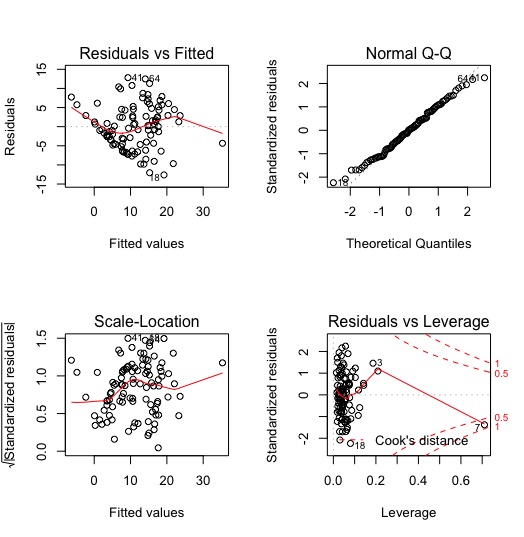
From the outputs of the model, there undoubtedly is a strong linear correlation between a SALARY per MILLIONS and the team PER. It makes logical sense because teams with more talented players are supposed to win proportionally more games. The relatively high R2 values and significant F-statistics confirm the goodness of fit of the model. There, however, still are some issues and complications about the model that I would like to discuss.
Welch Two Sample t-test proves that the results are statistically significant as the p-value is a lot smaller. So the alternative hypothesis is true as the difference in means is not equal to zero. In the end it shows that NBA players with certain set of proficiencies are more likely to have more twitter followers than other players.
Support Vector Machines with Radial Basis Function Kernel
76 samples
62 predictors
No pre-processing
Resampling: Cross-Validated (10 fold, repeated 3 times)
Summary of sample sizes: 68, 70, 68, 68, 68, 69, …
Resampling results across tuning parameters:
C RMSE Rsquared MAE
0.25 8.258797 0.3890508 7.248933
0.50 7.939011 0.4037353 6.771456
1.00 7.447366 0.4106806 6.070366
2.00 7.228367 0.4136702 5.720482
4.00 7.110805 0.4067402 5.620212
Tuning parameter ‘sigma’ was held constant at a value of 5.150215e-07
RMSE was used to select the optimal model using the smallest value.
The final values used for the model were sigma = 5.150215e-07 and C = 4.
The SVM model gives us good results on the test data. Every player who has twitter followers is accurately assessed. According to this model, some players who do not have followers could be wrongly assessed. In relative terms, this is an acceptable misdirection consider to the nature of the problem.
The results of this model is great, it is likely that this model will perform well. In addition, devising an efficient method of feature selection will have a great positive effect on the accuracy, specificity, and sensitivity of our model.
Players were not consistent in their game and/or not as good when they were playing on the road versus at home, or vice versa.
Teams went on long stretches of losing because of major injuries from key players, and did not bounce back quickly once those players returned to the line-up.
it is uncommon for players without high performance or maximum salary to have more followers and fans. For instance, they have a rather effective pick-and-roll offensive system that works well for them and thus they are sitting comfortably above the linear regression line in the scatterplot.
Sometimes fan followers between two teams do not necessarily depend on the players. It is hard to factor this other factor into the model because these other factors that do not show up tangibly in players’ stats upon which our model is based.
Predictions and Analysis
After building and analysing linear models from nba data set to predict re players performance, it is clearly visible that the red and blue dots in the scatterplot represent the actual win ratios of each team at the end of season. Yellow dots are predicted win ratios based on the model from season while the green dots are predicted win ratios based on the model from season
Since the model is in a way more biased towards players’ individual strengths, teams like the Celtics are negatively impacted and misjudged. A possible direction of further research into this topic is to find a solution to address this issue, devising a method that could capture how much better/worse players are collectively.
VALIDATION SAMPLING
The principles of data-splitting distinguish between fitting and validation samples – they are from the same data set but, at the same time, are distinct and independent from one other. Since the fitted model performs in an optimistic manner on the fitting sample, are to expect a lower performance of the model on the validation sample. The main focus is to measure the predictive performance of a model and its ability to accurately predict the outcome variable on new subjects. For the fitting sample it is interested in evaluating how well the model fits the data on which it was developed. Interest in the latter relates in particular to how much the performance ability decreases or degenerates from what was quantified in the fitting set.
Model Performance
The rpart model is the winner, RMSE of the different model from the below table and the below sensitivity plots demonstrate that the model is intuitive: Higher Salary leads to higher number of twitter follower.
The closest point of the line to the horizontal axis from the below graph represents the model with the smallest forecast errors and vice versa.
| MODEL | lm.mod | earth.mod | earth.pois.mod | party.mod | rpart.mod |
| RMSE | 44.85268 | 7.175672 | 9.99807 | 6.226008 | 6.108980 |
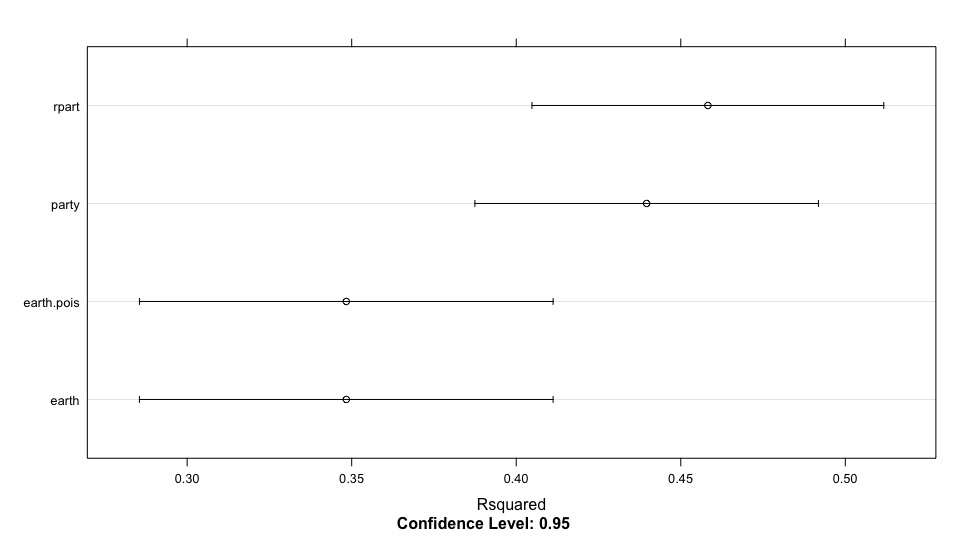
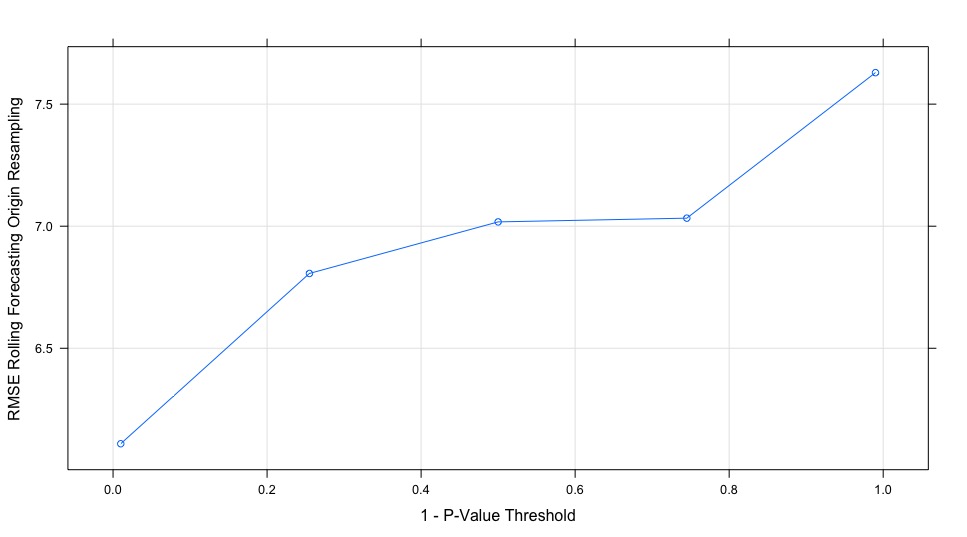
Although predicting the players contributions based on NBA advance statistics, it is impossible to get rid of the other factors involved in the game entirely. Sometimes worst player can surprisingly has more twitter followers. It is hard to analyse these factors into the model because it largely depends on the match-up and that do not show up tangibly in players’ statistics upon which our model is based. A possible mitigation is to add an additional term in the linear model to capture these factors.
Conclusion
NBA players wants to make the most money in salary should switch to teams that let them score and many NBA players do not have social Media handles and fan social engagement is a better predictor of true performance metrics than salary.
References
Gorton, B.A. Evaluation of the serve and pass in womens volleyball competition. Nfesters thesis, George Williams College, 1970.
Haberman, S.J. Analysis of scores of Ivy League football games. In S. Ladany & R. Machol (Eds.), Optimal strategies in sports. Amsterdam: New Holland, 1977.
Hildebrand, D.K., Laing, J.D. & Rosenthal, H. Prediction analysis of cross classifications. New York: John Wiley & Sons, 1977.
Hoehn, J.E. The Knox basketball test as a predictive measure of overall basketball ability in female high school basketball players. Masters thesis, Central Missouri State University, 1979.
Hopkins, D.R. Using skill tests to identify successful and unsuccessful basketball performers. Research Quarterly, 1980, 51, 381-387.
Kerlinger, F.N. & Pedhazur, E.J. Multiple regression in behavioral research. New York: Holt, Rinehart & Winston, Inc., 1973.
Kim, J.O. & Kohout, F.J. Multiple regression analysis: subprograms regression. In N.H. Nie, C.H. Hull, J.G. Jenkins, K. Steinbrenner, & D.J. Bent, (Eds.), SPSS-statistical package for the social sciences. New York: McGraw-Hill Book Co., 1975.
Lindsey, G.R. A scientific approach to strategy in baseball. In S. Ladany & R. Machol (Eds.), Optimal strategies in sports. Amsterdam: New Holland, 1977.
Miller, K. & Horky, R.J. Modern basketball for women. Columbus, Oh.: Charles E. Merrill Publishing Co., 1970.
Nie, N.H., Hull, C.H., Jenkins, J.G. Steinbrenner, K., & Bent, D.H. SPSS-statistical package for the social sciences. New York: McGraw-Hill Book Co., 1975.
Peterson, J.T. The prediction of basketball performance. California, 1980, 42, 21.
Press, S.J. & Wilson, S. Choosing between logistic regression and discriminant analysis. Journal of the American Statistical Association, 1973, 699-705.
63 Price, B. & Rao, A. A model for evaluating player performance in professional basketball. In S. Ladany & R. Machol (Eds.), Optimal strategies in sports. Amsterdam: New Holland, 1977.
Schultz, R.W. Sports and mathematics: a definition and delineation. ResearchQuarterly,1980,5J_, 37-49.
Scott, R.J. The relationship of statistical charting to team success in volleyball. listers thesis, University of California, Los Angeles, 1971.
Wilson, G.E. A study of the factors and results of effective team rebounding in high school basketball. Master’s thesis, University of Iowa, 1948.
Pragmatic AI: An Introduction to Cloud-Based Machine Learning, First Edition by Noah Gift , Published by Addison-Wesley Professional, 2018
Appendix
Variable Names
PLAYER_ID
Player unique id
PLAYER_NAME
Player’s name.
TEAM_ID
Player’s team unique id.
TEAM_ABBREVIATION
Abbreviation for the team the player is on.
AGE
Player age.
GP
Games played.
W
Games played where the team won.
L
Games played where the team lost.
W_PCT
Percentage of games played won.
MIN
Minutes played.
OFF_RATING
Player offensive rating.
DEF_RATING
Player defensive rating.
NET_RATING
Average of the offensive/defensive rating.
AST_PCT
Assist percentage.
AST_TO
Assists-to-turnovers.
AST_RATIO
Assists-to-turnovers ratio.
OREB_PCT
Offensive rebounds.
DREB_PCT
Defensive rebounds.
REB_PCT
Total rebounds.
TM_TOV_PCT
Team turnover rate.
EFG_PCT
Effective field goal percentage. This is an imputed statistic.
TS_PCT
True Shooting Percentage; an imputed measure of shooting efficiency.
USG_PCT
Usage percentage, an estimate of how often a player makes team plays.
PACE
Pace factor, an estimate of the number of possessions.
PIE
Player impact factor, a statistic roughly measuring a player’s impact on the games that they play that’s used bynba.com.
FGM
Field goals made.
FGA
Field goals attempted.
FGM_PG
Field goals made percentage.
FGA_PG
Field goals attempted percentage.
FG_PCT
Field goals total percentage.
GP_RANK
Games played, league rank.
W_RANK
Wins, league rank.
L_RANK
Losses, league rank.
W_PCT_RANK
Win percentage, league rank.
MIN_RANK
Minutes played, league rank.
OFF_RATING_RANK
Offensive rating, league rank.
DEF_RATING_RANK
Defensive rating, league rank.
NET_RATING_RANK
Net rating, league rank.
AST_PCT_RANK
Assists percentage, league rank.
AST_TO_RANK
Assists-to-turnovers, league rank.
AST_RATIO_RANK
Assist ratio, league rank.
OREB_PCT_RANK
Offensive rebounds percentage, league rank.
DREB_PCT_RANK
Defensive rebounds percentage, league rank.
REB_PCT_RANK
Rebounds percentage, league rank.
TM_TOV_PCT_RANK
Team turnover, league rank.
EFG_PCT_RANK
Effective field goal percentage, league rank.
TS_PCT_RANK
True shooting percentage, league rank.
USG_PCT_RANK
Usage percentage, league rank.
PACE_RANK
Pace score, league rank.
PIE_RANK
Player impact, league rank.
FGM_RANK
Field goals made, league rank.
FGA_RANK
Field goals attempted, league rank.
FGM_PG_RANK
Field goals made percentage, league rank.
FGA_PG_RANK
Field goal attempted percentage, league rank.
FG_PCT_RANK
Field goal percentage, league rank.
CFID
CFPARAMS
WIKIPEDIA_HANDLE
Player’s name on Wikipedia
TWITTER_HANDLE
Twitter handle.
SALARY_MILLIONS
Salary.
PTS
Points scored.
ACTIVE_TWITTER_LAST_YEAR
Whether or not the player was active (posted) on Twitter last year.
TWITTER_FOLLOWER_COUNT_MILLIONS
Number of Twitter followers.
R CODE
nba
attach(nba)
head(nba)
summary(nba)
str(nba)
fit1
fit1
library(corrplot)
cor(data.frame(GP, W, L, W_PCT))
Games
Games
corrplot.mixed(Games)
ODN
ODN
corrplot.mixed(ODN)
ASS
ASS
corrplot.mixed(ASS)
REB
REB
corrplot.mixed(REB)
a
a
corrplot.mixed(a)
b
b
corrplot.mixed(b)
FG
FG
corrplot.mixed(FG)
TWI
TWI
corrplot.mixed(TWI)
total
corrplot.mixed(total)
fit2
summary(fit2)
fit3
summary(fit3)
t.test(nba$SALARY_MILLIONS,nba$TWITTER_FOLLOWER_COUNT_MILLIONS)
#best fit model
fit
par(mfrow=c(2,2))
plot(fit)
nba
set.seed(50)
sample_index
nba_training
nba_testing
nba_mod_r2
summary(nba_mod_r2)
par(mfrow = c(1, 2))
plot(nba_mod_r2, which = c(1, 2))
predictions_adjr2
predictions_adjr2
nba_df
jr2,
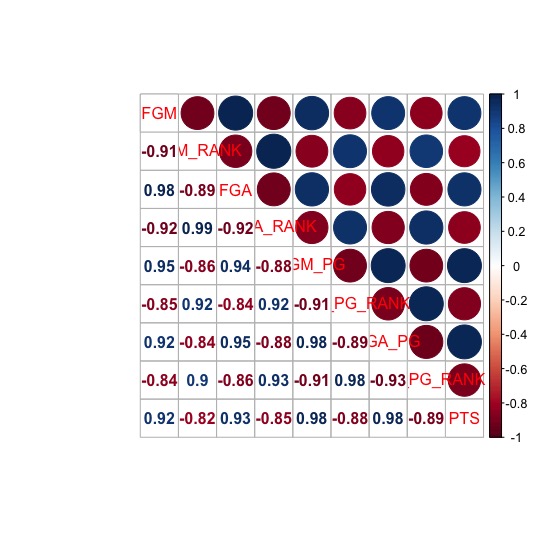

values = nba_testing$SALARY_MILLIONS)
nba_df
library(ggplot2)
ggplot(nba_df, aes(predictions, values)) +
geom_point() +
geom_smooth(method = “lm”, color = “red”) +
labs(x = “Predicted Values”, y = “Actual Values”) +
theme_minimal()
library(dplyr)
nba_df %>%
mutate(residual = predictions – values) %>%
summarize(Mean_Difference = mean(abs(residual)))
library(car)
qqPlot(fit)
durbinWatsonTest(fit)
ncvTest(fit)
spreadLevelPlot(fit)
library(gvlma)
summary(gvlma(fit))
vif(fit)
sqrt(vif(fit))>2
outlierTest(fit)
influencePlot(fit, main=”Influence Plot”,
sub=”Circle size is proportional to Cook’s distance”)
relweights
R
nvar
rxx
rxy
svd
evec
ev
delta
lambda
lambdasq
beta
rsquare
rawwgt
import
import
row.names(import)
names(import)
import
dotchart(import$Weights, labels=row.names(import),
xlab=”% of R-Square”, pch=19,
main=”Relative Importance of Predictor Variables”,
sub=paste(“Total R-Square=”, round(rsquare, digits=3)),
…)
return(import)
}
relweights(fit)
nba
library(leaps)
regfit.full
full.summary
names(full.summary)
which.max(full.summary$rss);which.max(full.summary$adjr2);which.min(full.summary$cp);which.min(full.summary$bic)
library(ggvis)
rsq
names(rsq)
rsq %>%
ggvis(x=~ c(1:nrow(rsq)), y=~R2 ) %>%
layer_points(fill = ~ R2 ) %>%
add_axis(“y”, title = “R2”) %>%
add_axis(“x”, title = “Number of variables”)
par(mfrow=c(2,2))
plot(full.summary$rss ,xlab=”Number of Variables “,ylab=”RSS”,type=”l”)
plot(full.summary$adjr2 ,xlab=”Number of Variables “, ylab=”Adjusted RSq”,type=”l”)
# which.max(full.summary$adjr2)
points(9,full.summary$adjr2[9], col=”red”,cex=2,pch=20)
plot(full.summary$cp ,xlab=”Number of Variables “,ylab=”Cp”, type=’l’)
# which.min(full.summary$cp )
points(7,full.summary$cp[7],col=”red”,cex=2,pch=20)
plot(full.summary$bic ,xlab=”Number of Variables “,ylab=”BIC”,type=’l’)
# which.min(full.summary$bic )
points(3,full.summary$bic[3],col=”red”,cex=2,pch=20)
plot(regfit.full, scale=”adjr2″)
plot(regfit.full, scale=”Cp”)
plot(regfit.full, scale=’bic’)
library(leaps)
regfit.fwd
fwd.summary
names(fwd.summary)
which.max(fwd.summary$rss);which.max(fwd.summary$adjr2);which.min(fwd.summary$cp);which.min(fwd.summary$bic)
library(ggvis)
rsq
names(rsq)
par(mfrow=c(2,2))
plot(fwd.summary$rss ,xlab=”Number of Variables “,ylab=”RSS”,type=”l”)
plot(fwd.summary$adjr2 ,xlab=”Number of Variables “, ylab=”Adjusted RSq”,type=”l”)
# which.max(fwd.summary$adjr2)
points(8,fwd.summary$adjr2[8], col=”red”,cex=2,pch=20)
plot(fwd.summary$cp ,xlab=”Number of Variables “,ylab=”Cp”, type=’l’)
# which.min(fwd.summary$cp )
points(7,fwd.summary$cp[7],col=”red”,cex=2,pch=20)
plot(fwd.summary$bic ,xlab=”Number of Variables “,ylab=”BIC”,type=’l’)
# which.min(fwd.summary$bic )
points(3,fwd.summary$bic[3],col=”red”,cex=2,pch=20)
plot(regfit.fwd, scale=”adjr2″)
plot(regfit.fwd, scale=”Cp”)
plot(regfit.fwd, scale=’bic’)
regfit.bwd
bwd.summary
names(bwd.summary)
which.max(bwd.summary$rsq);which.max(bwd.summary$adjr2);which.min(bwd.summary$cp);which.min(bwd.summary$bic)
library(ggvis)
rsq
names(rsq)
rsq %>%
ggvis(x=~ c(1:nrow(rsq)), y=~R2 ) %>%
layer_points(fill = ~ R2 ) %>%
add_axis(“y”, title = “R2”) %>%
add_axis(“x”, title = “Number of variables”)
par(mfrow=c(2,2))
plot(bwd.summary$rss ,xlab=”Number of Variables “,ylab=”RSS”,type=”l”)
plot(bwd.summary$adjr2 ,xlab=”Number of Variables “, ylab=”Adjusted RSq”,type=”l”)
# which.max(bwd.summary$adjr2)
points(9,bwd.summary$adjr2[9], col=”red”,cex=2,pch=20)
plot(bwd.summary$cp ,xlab=”Number of Variables “,ylab=”Cp”, type=’l’)
# which.min(bwd.summary$cp )
points(7,bwd.summary$cp[7],col=”red”,cex=2,pch=20)
plot(bwd.summary$bic ,xlab=”Number of Variables “,ylab=”BIC”,type=’l’)
# which.min(reg.summary$bic )
points(3,bwd.summary$bic[3],col=”red”,cex=2,pch=20)
plot(regfit.bwd, scale=”adjr2″)
plot(regfit.bwd, scale=”Cp”)
plot(regfit.bwd, scale=’bic’)
coef(regfit.full, 7);coef(regfit.fwd, 7);coef(regfit.bwd, 7)
coef(regfit.full, 3);coef(regfit.fwd, 3);coef(regfit.bwd, 3)
###########################################################
install.packages(“factoextra”)
if(!require(devtools)) install.packages(“devtools”)
devtools::install_github(“kassambara/factoextra”)
library(factoextra)
library(“factoextra”)
data
head(data)
nba.active
##calculate the covariance matrix
cov_data
cov_data
eigen_data
eigen_data
res.pca
res.pca
res.pca$sdev^2
summary(res.pca)
names(res.pca )
biplot (res.pca , scale =FALSE)
res.pca$rotation=-res.pca$rotation
res.pca$x=res.pca$x
biplot (res.pca , scale =FALSE)
res.pca$sdev
pr.var =res.pca$sdev^2
pr.var
pve=pr.var/sum(pr.var)
pve
screeplot(res.pca, type = “lines”)
fviz_eig(res.pca)
fviz_pca_ind(res.pca,
col.ind = “cos2”, # Color by the quality of representation
gradient.cols = c(“#00AFBB”, “#E7B800”, “#FC4E07”),
repel = TRUE # Avoid text overlapping
)
fviz_pca_var(res.pca,
col.var = “contrib”, # Color by contributions to the PC
gradient.cols = c(“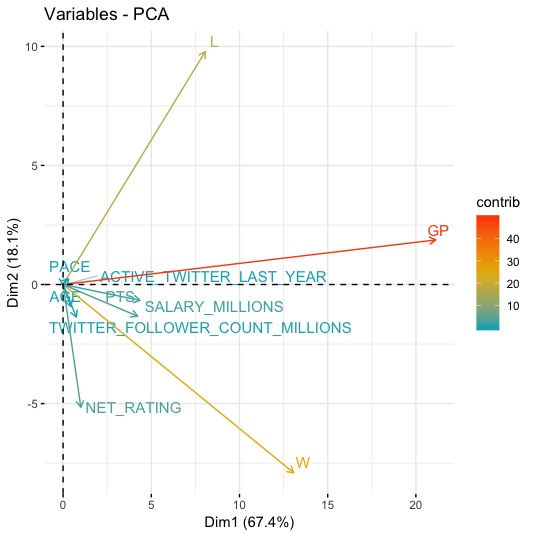 #00AFBB”, “#E7B800”, “#FC4E07”),
#00AFBB”, “#E7B800”, “#FC4E07”),
repel = TRUE # Avoid text overlapping
)
fviz_pca_biplot(res.pca, repel = TRUE,
col.var = “#2E9FDF”, # Variables color
col.ind = “#696969” # Individuals color
)
library(factoextra)
#eigen value
eig.val
eig.val
# Results for Variables
res.var
res.var$coord # Coordinates
res.var$contrib # Contributions to the PCs
res.var$cos2 # Quality of representation
# Results for individuals
res.ind
res.ind
res.ind$coord # Coordinates
res.ind$contrib # Contributions to the PCs
res.ind$cos2 # Quality of representation
# Data for the supplementary individuals
ind.sup
ind.sup[, 1:4]
ind.sup.coord
ind.sup.coord[, 5:7]
# Plot of active individualsp TRUE)
p
# Add supplementary individuals
fviz_add(p, ind.sup.coord, color =”blue”)
# Centering and scaling the supplementary individuals
ind.scaled
center = res.pca$center,
scale = res.pca$scale)
# Coordinates of the individividuals
coord_func
r
apply(r, 2, sum)
}
pca.loadings
ind.sup.coord
ind.sup.coord[, 1:4]
groups
fviz_pca_ind(res.pca,
col.ind = groups, # color by groups
palette = c(“#00AFBB”, “#FC4E07”),
addEllipses = TRUE, # Concentration ellipses
ellipse.type = “confidence”,
legend.title = “Groups”,
repel = TRUE
)
l
########################################################
mydata
attach(mydata)
head(mydata)
summary(mydata)
length(mydata$SALARY_MILLIONS)
mydata_train
mydata_test
## Step 3: Training a model on the data —-
# regression tree using rpart
library(rpart)
m.rpart
# get basic information about the tree
m.rpart
summary(m.rpart)
fancyRpartPlot(m.rpart, main = “Players Income Level”)
# use the rpart.plot package to create a visualization
par(mfrow=c(2,1))
#install.packages(“rpart.plot”)
library(rpart.plot)
# a basic decision tree diagram
rpart.plot(m.rpart, digits = 3)
# a few adjustments to the diagram
rpart.plot(m.rpart, digits = 4, fallen.leaves = TRUE, type = 3, extra = 101)
# compare the distribution of predicted values vs. actual values
p.rpart
p.rpart
mydata_test$SALARY_MILLIONS
confusionMatrix(p.rpart, mydata_test$SALARY_MILLIONS)
summary(p.rpart)
summary(mydata_test$SALARY_MILLIONS)
# compare the correlation
cor(p.rpart, mydata_test$SALARY_MILLIONS)
# function to calculate the mean absolute error
MAE
mean(abs(actual – predicted))
}
# mean absolute error between predicted and actual values
MAE(p.rpart, mydata_test$SALARY_MILLIONS)
MAE(5.87, mydata_test$SALARY_MILLIONS)
## Step 5: Improving model performance —-
#Train the BRT Model
#install.packages(“gbm”)
library(gbm)
library(tree)
gbm.model
gbm.model
gbmTrainPredictions = predict(object = gbm.model,
newdata = mydata_test,
n.trees = 100,
type = “response”)
#summary statistics about the predictions
summary(gbmTrainPredictions)
# compare the correlation
cor(gbmTrainPredictions, mydata_test$SALARY_MILLIONS)
#mean absolute error of predicted and true values
#(uses a custom function defined above)
MAE(mydata_test$SALARY_MILLIONS, gbmTrainPredictions)
#####################################################
nba
str(nba)
summary(nba)
library(caret)
library(e1071)
library(rpart)
library(mlbench)
da
nba
nba
inTrain
sample_index
c.train
c.test
control
# train the model using support vector machines radial basis function and using the above control
model
# summarize the model
print(model)
summary(model)
#install.packages(“kernlab”)
library(kernlab)
library(caret)
length(nba$SALARY_MILLIONS)
model = ksvm(data=c.train,SALARY_MILLIONS ~.,kernel=”vanilladot”,scale=F)
model
summary(model)
pred.1
pred.1
data.frame( R2 = R2(pred.1, c.test$SALARY_MILLIONS),
RMSE = RMSE(pred.1, c.test$SALARY_MILLION),
MAE = MAE(pred.1, c.test$SALARY_MILLION))
RMSE(pred.1, c.test$SALARY_MILLION)/mean(c.test$SALARY_MILLION)
cor(pred.1, c.test$SALARY_MILLIONS)
MAE = function(actual, predicted) {
mean(abs(actual – predicted))
}
MAE(pred.1, c.test$SALARY_MILLIONS)
summary(c.test$SALARY_MILLIONS)
model.rbf = ksvm(data=c.train,SALARY_MILLIONS ~.,kernel=”rbfdot”)
pred.rbf = predict(model.rbf, c.test)
pred.rbf
cor(pred.rbf, c.test$SALARY_MILLIONS)
MAE(pred.rbf, c.test$SALARY_MILLIONS)
##########################################################################
nba
knitr::kable(head(nba))
knitr::kable(tail(nba))
library(lubridate)
nba$SALARY_MILLIONS
set.seed(123)
seeds
for(i in 1:431) seeds[[i]]
library(doParallel)
library(caret)
myControl
horizon = 12,fixedWindow = FALSE,allowParallel = TRUE,
seeds = seeds)
tuneLength.num
nba
#Leave one out cross validation – LOOCV
library(caret)
train.control
# Train the model
lm.mod
trControl = train.control)
lm.mod
library(earth)
library(plotmo)
library(plotrix)
library(TeachingDemos)
earth.mod
earth.mod
earth.pois.mod
data = nba,
method = “earth”,
glm=list(family=poisson),
trControl = myControl,
tuneLength=tuneLength.num)
earth.pois.mod
library(rpart)
rpart.mod
rpart.mod
library(party)
library(grid)
library(mvtnorm)
library(modeltools)
library(stats4)
library(strucchange)
library(zoo)
party.mod
party.mod
resamps
resamps
ss
ss
knitr::kable(ss[[3]]$Rsquared)
resamps$metrics
library(lattice)
trellis.par.set(caretTheme())
dotplot(resamps, metric = “Rsquared”)
library(party)
library(grid)
library(mvtnorm)
library(modeltools)
library(stats4)
library(strucchange)
library(zoo)
party.mod$finalModel
#party.mod
plot(party.mod)
Cite This Work
To export a reference to this article please select a referencing stye below:
Related Services
View allRelated Content
All TagsContent relating to: "Social Media"
Social Media is technology that enables people from around the world to connect with each other online. Social Media encourages discussion, the sharing of information, and the uploading of content.
Related Articles
DMCA / Removal Request
If you are the original writer of this dissertation and no longer wish to have your work published on the UKDiss.com website then please:




